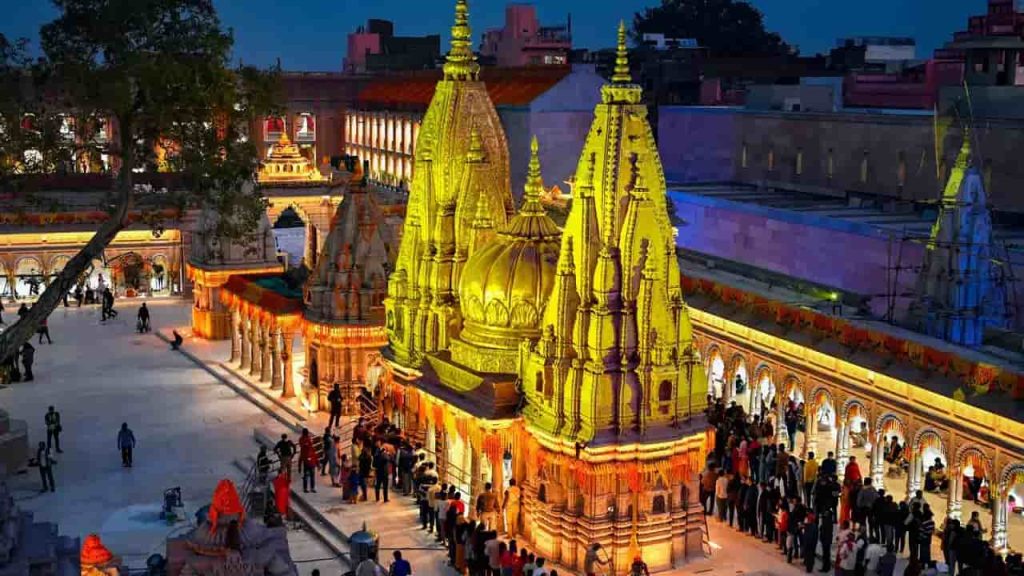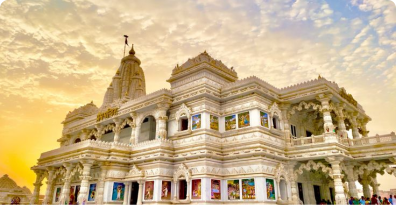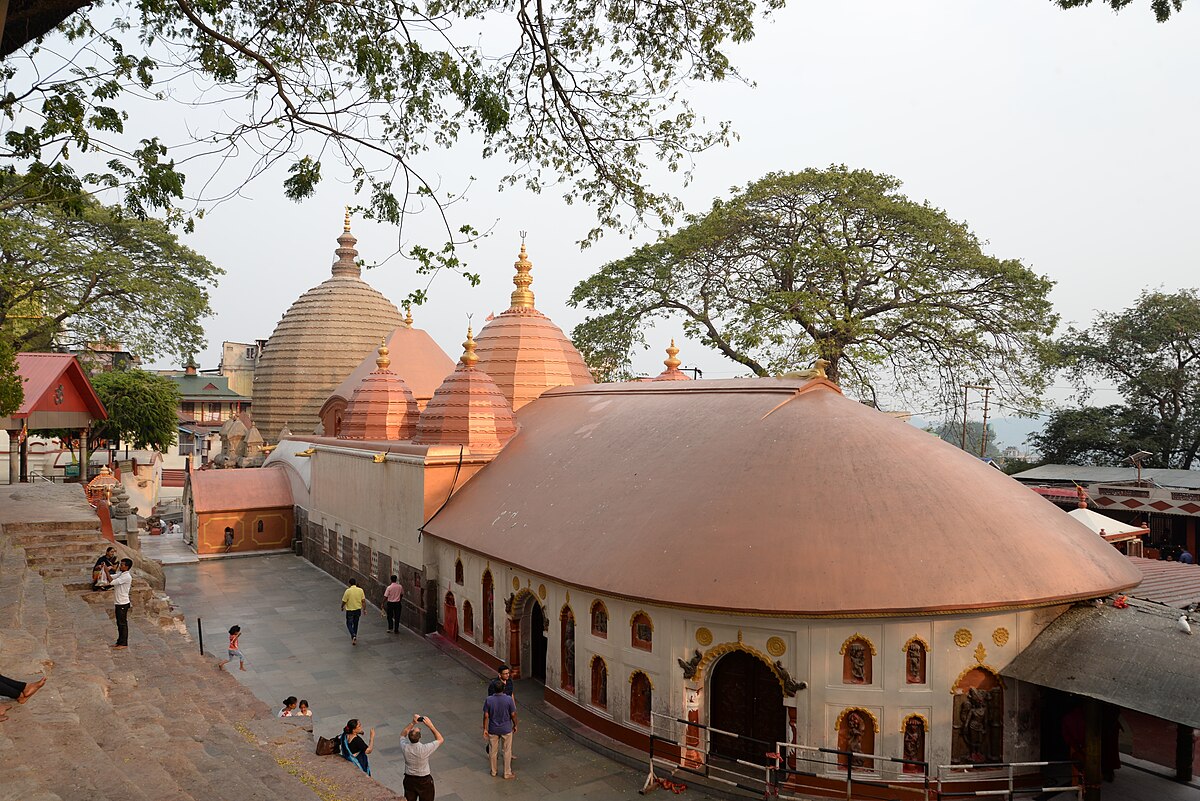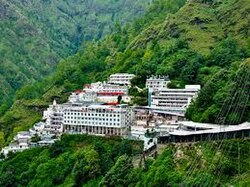
October 06, 2025
Temple Mandir
6 min read
Kashi Vishwanath Temple
Nestled on the banks of the sacred Ganges in Varanasi, Kashi Vishwanath Temple stands as one of the most revered shrines in India. Dedicated to Lord Shiva, this temple is not just an architectural marvel but a spiritual beacon that has drawn devotees for centuries. Believed to be one of the twelve Jyotirlingas, Kashi Vishwanath symbolizes the eternal connection between the human soul and the divine. Legends say that visiting this temple and offering prayers can liberate one from the cycle of birth and death, granting moksha. Beyond its spiritual aura, the temple’s bustling surroundings reflect the vibrant culture, rituals, and timeless traditions of Varanasi, making it a place where history, mythology, and devotion converge beautifully.
Kashi Vishwanath Temple, Varanasi: The Eternal Abode of Lord Shiva
Introduction
Kashi Vishwanath Temple, located on the western bank of the sacred River Ganga in Varanasi, Uttar Pradesh, is one of the most revered Hindu temples in India. Dedicated to Lord Shiva, who is worshipped here as Vishwanath (Lord of the Universe), the temple has been a spiritual center for thousands of years. Varanasi, also called Kashi, is considered the city of light, where the cycle of life and death meets the promise of liberation or Moksha.
For centuries, devotees have believed that a pilgrimage to Kashi Vishwanath can cleanse all sins and free the soul from the cycle of birth and death. The temple is not only a place of worship but a living testament to India’s rich spiritual and cultural heritage.
Historical Background
The history of Kashi Vishwanath Temple is a tale of devotion, destruction, and resilience. According to legend, the Shiva Linga here is self-manifested, known as a Swayambhu Lingam, and has existed since time immemorial. The temple has been destroyed and rebuilt multiple times by different rulers, yet its spiritual aura has remained intact.
The earliest references to Kashi Vishwanath appear in ancient Puranas, which describe the city of Kashi as a place where Lord Shiva himself dwells to guide and protect humanity. Archaeological evidence suggests that temples dedicated to Vishwanath existed here at least 1,000 years ago, though the original structure was repeatedly destroyed during medieval invasions.
The present structure was built in 1780 by Maharani Ahilya Bai Holkar of Indore, one of India’s most revered queens known for her devotion and patronage of temples. The temple complex, with its golden spire and sanctum, gleams as a symbol of divine power and human resilience.
The architectural style reflects North Indian temple architecture, with intricately carved pillars, domes, and a sanctum that houses the sacred Shiva Lingam. The golden dome, plated with gold donated by Maharaja Ranjit Singh in the 19th century, continues to attract devotees and tourists from around the world.
Myths & Stories
Kashi Vishwanath Temple is steeped in mythology and legends. One popular story is that of Lord Shiva and Goddess Parvati’s cosmic play. It is believed that Kashi was created by Lord Shiva himself, and whoever dies here attains Moksha (liberation from the cycle of birth and death).
According to another legend, a demon named Bhasmasura received a boon from Lord Shiva that he could turn anyone to ashes by touching their head. However, he misused this power, and Lord Vishnu incarnated as Mohini to trick the demon, eventually saving the world. This story emphasizes the protective power of Shiva and Vishnu, which devotees feel intensely when visiting the temple.
Another fascinating tale involves Tulsidas, the author of Ramcharitmanas. It is said that Tulsidas, after a long spiritual quest, had a vision of Lord Shiva here, which inspired him to compose hymns that continue to resonate through the corridors of Kashi Vishwanath.
The temple’s location on the holy Ganga adds to its mystical aura. It is believed that bathing in the river before visiting the temple purifies both body and soul, allowing devotees to experience the divine presence of Lord Shiva more vividly.
Festivals & Rituals
The temple is alive with vibrant rituals and grand festivals throughout the year. The most celebrated festival is Maha Shivratri, the night dedicated to Lord Shiva. Devotees gather in thousands, chanting mantras and singing bhajans, creating an atmosphere of deep devotion and spiritual energy.
Other important festivals include Shravan Maas (the holy month of Shravan), Pradosh Vrat, and Kartika Purnima, where special rituals are performed to honor Lord Shiva. During these times, the temple is adorned with flowers, lamps, and offerings, and devotees participate in night-long vigils and ceremonial worship.
Daily rituals in the temple include Abhishekam (ritual bathing of the Shiva Lingam), Aarti (ceremonial light offering), and Archana (personalized prayers). The priests perform these ceremonies with a sense of timeless devotion, creating an immersive spiritual experience for visitors.
A unique ritual at Kashi Vishwanath is the sacred “Ganga Snan”, where devotees take a dip in the river Ganga before entering the temple. It is believed that the combination of holy water and the divine vibrations from the Lingam accelerates spiritual purification.
Visitor Experience
Visiting Kashi Vishwanath Temple is an immersive experience, not just a spiritual journey but also a cultural exploration. The temple complex is located in the heart of Varanasi, surrounded by narrow lanes, bustling markets, and vibrant street food stalls, giving visitors a glimpse into the city’s ancient lifestyle.
Devotees and tourists should plan their visit carefully. The temple is open from 4:00 AM to 11:00 PM, with peak visiting times during early mornings and evenings. Security checks are strict, but the organized entry system ensures smooth flow despite the large crowds.
Nearby attractions include Dashashwamedh Ghat, Manikarnika Ghat, and the Ganga Aarti, which is a mesmerizing evening ritual by the river. Exploring these alongside the temple visit allows one to experience the full spiritual and cultural essence of Varanasi.
A visit here is also an opportunity to taste local delicacies, such as Kashi’s famous sweets like malaiyo, rabri, and chaats, which are part of the city’s vibrant culinary tradition.
For international and out-of-state tourists, guided tours are available, offering insights into the mythology, history, and architecture of the temple. Photography is restricted inside the sanctum, but the golden spire and outer courtyards provide stunning views and memories to cherish.
Spiritual Significance
Kashi Vishwanath Temple is not just a religious monument; it is a spiritual powerhouse. Devotees believe that praying here with sincere devotion can remove obstacles, fulfill desires, and cleanse karma. The temple embodies the essence of Shaivism, emphasizing detachment, meditation, and the pursuit of spiritual truth.
The temple’s influence extends beyond religion. Philosophers, poets, and saints have long revered Kashi as a source of wisdom and inspiration. Visiting the temple allows one to connect with centuries of devotion, hear the resonating chants of “Om Namah Shivaya,” and feel the profound energy of the sacred city.
A unique aspect of Kashi Vishwanath is the belief in instant liberation. Unlike other pilgrimage sites, where spiritual progress is considered gradual, Kashi promises Moksha to the soul, making it a lifelong aspiration for every devout Hindu.
Conclusion
Kashi Vishwanath Temple stands as a timeless symbol of faith, resilience, and spiritual wisdom. From its ancient myths to its vibrant festivals, every corner of the temple resonates with divine energy. A visit to this sacred abode of Lord Shiva is not merely a journey across space but a journey within, offering peace, enlightenment, and a deep connection with the eternal.
Whether you are a devotee seeking blessings, a history enthusiast exploring architecture, or a traveler in search of cultural immersion, Kashi Vishwanath Temple offers a profound experience that leaves a lasting imprint on the heart and soul.
The golden spire, the sacred Ganga, the echoing chants, and the stories of devotion create a tapestry that is as timeless as the city of Kashi itself, inviting all to witness the eternal dance of Lord Shiva.
Introduction
Kashi Vishwanath Temple, located on the western bank of the sacred River Ganga in Varanasi, Uttar Pradesh, is one of the most revered Hindu temples in India. Dedicated to Lord Shiva, who is worshipped here as Vishwanath (Lord of the Universe), the temple has been a spiritual center for thousands of years. Varanasi, also called Kashi, is considered the city of light, where the cycle of life and death meets the promise of liberation or Moksha.
For centuries, devotees have believed that a pilgrimage to Kashi Vishwanath can cleanse all sins and free the soul from the cycle of birth and death. The temple is not only a place of worship but a living testament to India’s rich spiritual and cultural heritage.
Historical Background
The history of Kashi Vishwanath Temple is a tale of devotion, destruction, and resilience. According to legend, the Shiva Linga here is self-manifested, known as a Swayambhu Lingam, and has existed since time immemorial. The temple has been destroyed and rebuilt multiple times by different rulers, yet its spiritual aura has remained intact.
The earliest references to Kashi Vishwanath appear in ancient Puranas, which describe the city of Kashi as a place where Lord Shiva himself dwells to guide and protect humanity. Archaeological evidence suggests that temples dedicated to Vishwanath existed here at least 1,000 years ago, though the original structure was repeatedly destroyed during medieval invasions.
The present structure was built in 1780 by Maharani Ahilya Bai Holkar of Indore, one of India’s most revered queens known for her devotion and patronage of temples. The temple complex, with its golden spire and sanctum, gleams as a symbol of divine power and human resilience.
The architectural style reflects North Indian temple architecture, with intricately carved pillars, domes, and a sanctum that houses the sacred Shiva Lingam. The golden dome, plated with gold donated by Maharaja Ranjit Singh in the 19th century, continues to attract devotees and tourists from around the world.
Myths & Stories
Kashi Vishwanath Temple is steeped in mythology and legends. One popular story is that of Lord Shiva and Goddess Parvati’s cosmic play. It is believed that Kashi was created by Lord Shiva himself, and whoever dies here attains Moksha (liberation from the cycle of birth and death).
According to another legend, a demon named Bhasmasura received a boon from Lord Shiva that he could turn anyone to ashes by touching their head. However, he misused this power, and Lord Vishnu incarnated as Mohini to trick the demon, eventually saving the world. This story emphasizes the protective power of Shiva and Vishnu, which devotees feel intensely when visiting the temple.
Another fascinating tale involves Tulsidas, the author of Ramcharitmanas. It is said that Tulsidas, after a long spiritual quest, had a vision of Lord Shiva here, which inspired him to compose hymns that continue to resonate through the corridors of Kashi Vishwanath.
The temple’s location on the holy Ganga adds to its mystical aura. It is believed that bathing in the river before visiting the temple purifies both body and soul, allowing devotees to experience the divine presence of Lord Shiva more vividly.
Festivals & Rituals
The temple is alive with vibrant rituals and grand festivals throughout the year. The most celebrated festival is Maha Shivratri, the night dedicated to Lord Shiva. Devotees gather in thousands, chanting mantras and singing bhajans, creating an atmosphere of deep devotion and spiritual energy.
Other important festivals include Shravan Maas (the holy month of Shravan), Pradosh Vrat, and Kartika Purnima, where special rituals are performed to honor Lord Shiva. During these times, the temple is adorned with flowers, lamps, and offerings, and devotees participate in night-long vigils and ceremonial worship.
Daily rituals in the temple include Abhishekam (ritual bathing of the Shiva Lingam), Aarti (ceremonial light offering), and Archana (personalized prayers). The priests perform these ceremonies with a sense of timeless devotion, creating an immersive spiritual experience for visitors.
A unique ritual at Kashi Vishwanath is the sacred “Ganga Snan”, where devotees take a dip in the river Ganga before entering the temple. It is believed that the combination of holy water and the divine vibrations from the Lingam accelerates spiritual purification.
Visitor Experience
Visiting Kashi Vishwanath Temple is an immersive experience, not just a spiritual journey but also a cultural exploration. The temple complex is located in the heart of Varanasi, surrounded by narrow lanes, bustling markets, and vibrant street food stalls, giving visitors a glimpse into the city’s ancient lifestyle.
Devotees and tourists should plan their visit carefully. The temple is open from 4:00 AM to 11:00 PM, with peak visiting times during early mornings and evenings. Security checks are strict, but the organized entry system ensures smooth flow despite the large crowds.
Nearby attractions include Dashashwamedh Ghat, Manikarnika Ghat, and the Ganga Aarti, which is a mesmerizing evening ritual by the river. Exploring these alongside the temple visit allows one to experience the full spiritual and cultural essence of Varanasi.
A visit here is also an opportunity to taste local delicacies, such as Kashi’s famous sweets like malaiyo, rabri, and chaats, which are part of the city’s vibrant culinary tradition.
For international and out-of-state tourists, guided tours are available, offering insights into the mythology, history, and architecture of the temple. Photography is restricted inside the sanctum, but the golden spire and outer courtyards provide stunning views and memories to cherish.
Spiritual Significance
Kashi Vishwanath Temple is not just a religious monument; it is a spiritual powerhouse. Devotees believe that praying here with sincere devotion can remove obstacles, fulfill desires, and cleanse karma. The temple embodies the essence of Shaivism, emphasizing detachment, meditation, and the pursuit of spiritual truth.
The temple’s influence extends beyond religion. Philosophers, poets, and saints have long revered Kashi as a source of wisdom and inspiration. Visiting the temple allows one to connect with centuries of devotion, hear the resonating chants of “Om Namah Shivaya,” and feel the profound energy of the sacred city.
A unique aspect of Kashi Vishwanath is the belief in instant liberation. Unlike other pilgrimage sites, where spiritual progress is considered gradual, Kashi promises Moksha to the soul, making it a lifelong aspiration for every devout Hindu.
Conclusion
Kashi Vishwanath Temple stands as a timeless symbol of faith, resilience, and spiritual wisdom. From its ancient myths to its vibrant festivals, every corner of the temple resonates with divine energy. A visit to this sacred abode of Lord Shiva is not merely a journey across space but a journey within, offering peace, enlightenment, and a deep connection with the eternal.
Whether you are a devotee seeking blessings, a history enthusiast exploring architecture, or a traveler in search of cultural immersion, Kashi Vishwanath Temple offers a profound experience that leaves a lasting imprint on the heart and soul.
The golden spire, the sacred Ganga, the echoing chants, and the stories of devotion create a tapestry that is as timeless as the city of Kashi itself, inviting all to witness the eternal dance of Lord Shiva.


